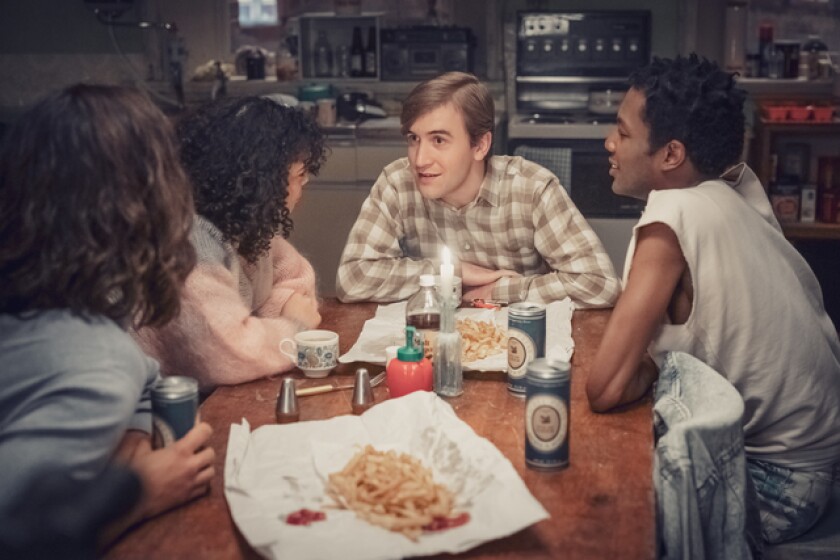
The following contains spoilers from the HBO Max limited series “It’s a Sin.”
Russell T Davies, creator of the acclaimed new limited series “It’s a Sin,” is a student of AIDS dramas. “I’m not saying I’ve seen everything,” he recently told the BBC, “but I probably have, because it interests me. It’s my life.”
Davies (“Queer as Folk,” “A Very English Scandal”) has made a career of representing gay lives in Britain, but had never confronted HIV/AIDS head-on in his work, despite — or perhaps because of — coming of age in the early 1980s, just as the epidemic was decimating the gay community (along with many others).
“It’s a Sin,” now streaming in the U.S. on HBO Max, focuses on five young friends in London at the start of the AIDS crisis, and has become the most-watched drama ever on Britain’s Channel 4, where it premiered late last month.
Davies has contended that the epidemic — the subject of such prestigious American projects as “Angels in America” and “The Normal Heart” — has not properly been depicted in a British context. “You haven’t seen this,” he reportedly argued with British TV commissioners. As such, alongside well-documented indignities faced by people with AIDS — plates of food left outside hospital doors, families burning their children’s belongings after death — “It’s a Sin” features numerous signposts specific to Prime Minister Margaret Thatcher’s Britain. Among them are her government’s infamous “Tombstone” ad and its homophobic Section 28 policy forbidding the “promotion” of homosexual lifestyles in schools.
With a specifically British inflection, Davies vividly evokes a climate of fear that saw gay men painted as pitiful victims, or worse, as potential killers capable of spreading the virus into the “general population” via the blood supply or continued sexual activity. Though many groups were and remain affected by the virus, gay men were singled out in the press and forever associated with it. Queer British filmmaker Stuart Marshall identified the new and harmful media image of the gay “AIDS victim” in a 1990 essay: “the object of pity, scorn or contempt who mumbles in a dark corner about his regrets, his fears, the dreadful price he has paid for his sexual freedom and his inevitable and imminent demise.”

Lydia West as Jill Baxter in “It’s a Sin.”
(Ben Blackall/HBO Max)
Watching Davies’ series more than 30 years later, as a person living with HIV myself, I see troubling vestiges of the same moralism: Certain tropes may have mutated since the days when headlines shouted “Britain Threatened by Gay Plague,” but they are no less pernicious for being less obvious or for coming from the pen of a gay creator.
In “It’s a Sin,” structures of blame and mysteries of transmission drive the narrative, recalling the sensational (and inaccurate) notion, at the center of gay journalist Randy Shilts’ bestselling AIDS history “And the Band Played On,” that the plague in the U.S. could be traced back to a sexually active gay flight attendant known as “Patient Zero.” This becomes apparent in the third episode when the innocent, seemingly virginal Colin (Callum Scott Howells) is mysteriously struck down with AIDS-related illness, and Davies’ script fixates on the question of how Colin contracted HIV. The identity of his sole sexual partner is revealed as a shocking plot twist through flashbacks of their sex, distastefully intercut with shots of the dying boy. Davies and his editor bring Colin’s story full circle, reducing him to one type of “AIDS victim”: the innocent naif, doomed from his first sexual encounter.
As the series proceeds, an economy of pleasure paid for by death recurs in the script. We watch the protagonist, Ritchie (Olly Alexander), joyously bonk half of London, only to see his sexual enthusiasm grow more ominous as the epidemic advances. Like Colin, he too regresses, first running from the reality of his HIV diagnosis back home to the Isle of Wight, an abject figure begging his (straight) high school crush for oral sex: “You could just lie back and close your eyes.”
Libertine Ritchie becomes the other side of the “AIDS victim” coin, lashing himself for his compulsive sexual behavior. By the time he’s in the hospital, Ritchie’s internalized so much homophobia that he implicates himself as his own Patient Zero for continuing, pathologically, to have unprotected sex: “I knew it was wrong and I kept on doing it. I wonder how many I killed?”
These two boys represent the sum total of people with AIDS to whom Davies grants major plotlines. After their deaths, it is up to their straight friend, Jill (Lydia West), to speak for them. In the final episode, Ritchie’s moralistic logic of blame isn’t refuted but turned toward a new target. Davies gives Jill a concluding speech to Ritchie’s mother that assigns blame for his crimes — “he killed people!” — not to his own agency but to the family that never taught him to properly love: “He was ashamed, he kept on being ashamed, he kept shame going by having sex with men, infecting them and then running away.” In a damning diagnosis of Ritchie and the wards “full of men who think they deserve it,” Davies, through Jill, paints a portrait of young men so crippled by homophobia that they lack any responsibility or ethics and pursue sex as a symptom of shame.

Callum Scott Howells as Colin, center, with Omari Douglas as Roscoe, right, in “It’s a Sin.”
(Ben Blackall/HBO Max)
Davies’ representation of the epidemic elicits pity rather than solidarity and ultimately offers a narrow, hopeless view of Britain’s queer community to its huge audience.
This selective history is only compounded by the series’ positioning as the first to tell the story of AIDS on British TV, when in truth experimental films about AIDS appeared on television there throughout the first decade of the epidemic, notably on Channel 4 itself. The network was established in 1982 with a remit to “appeal to tastes and interests not generally catered for” by existing British broadcasters, and the wide range of queer work it commissioned included Derek Jarman’s AIDS elegy “Blue” (1993) and Marshall’s AIDS activist films “Bright Eyes” and “Over Our Dead Bodies.” If Davies found time to resurrect the Tombstone ad and the 1980s version of “Doctor Who,” why couldn’t any of “It’s a Sin’s” lead quintet have been seen watching the gay anthology series “Out on Tuesday”?
Of course, those earlier programs were not “mainstream” in the way that “It’s a Sin” aims to be. They represented the queer and AIDS-affected population to itself, rather than to the “broader” population. Such exercises in outreach can be hugely valuable, but if they’re aimed at a mostly uninformed audience, with little knowledge of HIV, they carry an even heavier burden of representation.
The accepted formulation now is to speak of people living with HIV. That change in terminology has been prompted by the advent of effective medication, which remains accessible to far too few (even in the United States). But even back in the 1980s, as FX’s series “Pose” proves, people with HIV/AIDS spent time living, coping, speaking up and having sex.
In another of his ironic twists, Davies ends the series’ penultimate episode with Ritchie bleeding in the back of a van, on the verge of confessing his HIV status to his friends. “I wanted you to be the first to know … ,” he says haltingly, “I’m gonna live.” If only this series had spent more time showing us how that could happen.
‘It’s a Sin’
Where: HBO Max
When: Any time
Rating: TV-MA (may be unsuitable for children under the age of 17)